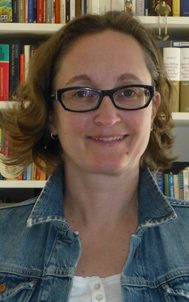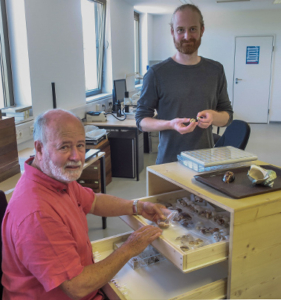Malacological Working Group
at the Haus der Natur in Salzburg

Robert Patzner began working on aquatic mollusks in the province of Salzburg in the 1990s. Together with his students he worked on the distribution and ecology of aquatic molluscs in Salzburg. In the course of a master thesis, he had insight into the partly completely disordered mollusc collection at the Haus der Natur and founded 2014 together with some of his former students the Malacological Working Group at the Haus der Natur. Since this time, he is busy with the processing of the collection.

Rita Schrattenecker-Travnitzky performed her PhD thesis on distribution, ecology and gonadal cycle of the genus Vertigo at the University of Salzburg, supervised by Robert Patzner. Since 2009 she is active as a zoological expert in nature conservation issues and has been working on terrestrical gastropods. Furthermore, she reorganised the malacological collection at the Biologische Station Neusiedler See and helped with the re-determination of the collection Sperling at the Haus der Natur Salzburg.

Verena Gfrerer is working as an expert in species protection at the Landesumweltanwaltschaft Salzburg. She studied ecology/environmental biology at the University of Salzburg. Her main expertise lies in the field of limnology and stream ecology and is interested in aquatic molluscs, native crayfish as well as dragonfly communities and accompanied a research project on the distribution and taxonomy of spring snails, genus Bythinella.

Stefan Kwitt studied biology at the University of Salzburg. During his studies, he started to volunteer in the Malacological Working Group at the Haus der Natur Salzburg and is mainly working on the mollusc collection of Peter Sperling. Meanwhile, he is responsible for the digitization and inventory of the collection via a project position as a research assistant. He is also contributing his knowledge to a pilot project of the initiative "Open Scientific Collections Austria" (OSCA).

Anke Oertel is curator of the public aquarium at Haus der Natur since 2015. Her malacological interest are aquatic mollusks, especially cave snails.

Belinda Stockinger is an enthusiastic scuba diver and is interested in marine snails – especially Opisthobranchia. She works voluntarily in the processing of the marine shells in the collection at the Haus der Natur to acquire in-depth specialist knowledge.

Christine Neudecker is a former student of Robert Patzner at the University of Salzburg and now working in STEM education. She helped to catalogue diverse mollusc collections at the Haus der Natur.

Aynur Avant was the first to start work on the malacological collection at Haus der Natur in 2012. In her master thesis she worked on naiads (Unionidae) of Europe and other countries of the world.

Christa Frank worked several years at the University of Graz then at the Biological Institute Neusiedlersee/Illmitz and finally was lecturer at the Institute of Zoology, Paleontology and Anthropology at the University of Vienna. She is still working on the mollusc fauna of Austria but also of other European countries and the Caribbean Islands.

Terrestrial molluscs in the province of Salzburg
Before the Sperling collection became known in 2016, the collection of Friedrich Mahler in Kremsmünster and the collection of Walter Klemm in the Natural History Museum in Vienna were the most important collections containing specimen of terrestrial snails from Salzburg. These two collections were mainly from the middle of the 20th century. There are also some specimens from Salzburg in the collection of Fritz Seidl in the Biology Centre Linz.
Since the 2000s, there has again been increased collecting activity through the work of Rita Schrattenecker-Travnitzky. Since the foundation of the Malacological Working Group at the Haus der Natur Salzburg in 2014, these activities have been intensified. All data are recorded in the Salzburg Biodiversity Database. In recent years, several new species have been recorded for Salzburg. Most of them were introduced species. Since 2020, there is a cooperation agreement between the Haus der Natur and the nature observation platform Observation.org. The experts at the Haus der Natur and from the working groups use Observation to record data and review incoming observations. In exchange, the data obtained will be transferred to the Salzburg Biodiversity Database. The Malacological Working Group also uses the tool to record and map terrestrial snails in Salzburg and other parts of Austria.
Further reading:
Bamberger S., Beiser G. & S. Kwitt (2022): Molluskenfunde in Salzburg – Bericht zum Tag der Artenvielfalt 2021 im Oberen Murtal und zu bemerkenswerten Nachweisen bei St. Michael im Lungau. Arianta 9: 16-24, Wien.
Kwitt, S. (2020): Ein Nachweis von Deroceras invadens Reise & al. 2011 beim Salzburger Volksgarten (Österreich). Nachr.bl. erste Vorarlb. malak. Ges. 27: 11-14, Rankweil.
Kwitt S. (2021): Verwendung von Observation.org zur malakologischen Kartierung. Newsletter Malakol. Arbeitsgem. Haus der Natur Salzburg 15: 5.
Kwitt S. & R.A. Patzner (2017): Zwei interessante Schnecken-Arten im Stadtgebiet von Salzburg: Monacha cartusiana (O.F. Müller, 1774) und Hygromia cinctella (Draparnaud, 1801) (Gastropoda, Hygromiidae). Linzer biol. Beiträge 0049_1: 663-667.
Kwitt S. & R.A. Patzner (2019): Nachweise von Charpentieria itala (Martens, 1824) in Salzburg (Gastropoda, Clausiliidae). Linzer biol. Beiträge 0051_2: 1115-1118.
Kwitt S. & R.A. Patzner (2020): Ein Beitrag zur Molluskenfauna von den Stadtbergen in Salzburg. Mitt. Haus der Natur Salzburg 26: 15-24.
Kwitt S. & R.A. Patzner (2022): Ein Nachweis von Deroceras agreste (Linnaeus, 1758) (Gastropoda: Agriolimacidae) aus Bad Gastein (Salzburg, Österreich). Arianta 9: 33-36, Wien.
Kwitt S., Patzner R.A. & P. L. Reischütz (2019): Die Ergebnisse einer Untersuchung der terrestrischen Molluskenfauna der Gewächshäuser des Botanischen Gartens der Universität Salzburg. Nachr.bl. erste Vorarlb. malak. Ges. 26: 69-74, Rankweil.
Kwitt S., Schrattenecker-Travnitzky R., Duda M., Neiber M.T. & R.A. Patzner (2019): Report of an excursion in the course of the 1st Meeting of the Society Mollusc Research Austria (MoFA) in the Untersberg area, Salzburg. Arianta 7: 14-7, Wien.
Travnitzky R. & R.A. Patzner (2009): Beitrag zur Molluskenfauna (Gastropoda und Bivalvia) des Bundeslandes Salzburg, Österreich mit besonderer Berücksichtigung der Vertigo-Arten. Linzer biol. Beitr. 41: 2039-2050.

Freshwater molluscs in the province of Salzburg
Since the year 1993, aquatic molluscs in the province of Salzburg have been collected and mapped under the direction of Robert A. Patzner. First by the “Biologische Unterwasser-Forschungsgruppe der Universität Salzburg” (BUFUS) at the University of Salzburg, then from 2014 by the Malacological Working Group at the Haus der Natur. All data are recorded in the Salzburg Biodiversity Database. Through new findings, the knowledge about the occurrence and distribution of water snails and mussels in the entire province is continuously expanded.
The most important collection of Salzburg aquatic molluscs is found in the Friedrich Mahler collection at Kremsmünster. The Walter Klemm collection is housed in the Natural History Museum in Vienna. Further collection specimens can be found in the Upper Austrian Landesmuseum in Linz.
Further reading:
Patzner R.A. (1995): Wasserschnecken und Muscheln im Bundesland Salzburg. Stand zu Beginn einer landesweiten Kartierung. Nachr.bl. erste Vorarlb. malak. Ges. 3: 12-29. http://www.zobodat.at/pdf/NachErstMalaGes_4_0023.pdf (CITE)
Patzner R.A., 2015: Übernahme von Süßwasser-Mollusken der Kollektion Patzner am Haus der Natur in Salzburg. Mitt. Haus der Natur 22: 85-92.
Patzner R.A. (2019): Mollusken am Haus der Natur in Salzburg. Denisia 52: 579-589.

Malacological collection of Peter Sperling
In 2016, the existence of a previously private malacological collection of the teacher Peter Sperling (Salzburg) became known. Due to his acquaintanceship with the malacologists Friedrich Mahler and Walter Klemm, Sperling began to collect predominantly terrestrial snails in the early 1950s. In 2017, with support of the state of Salzburg, the collection was bought from the estate of Peter Sperling and then housed at the Haus der Natur Salzburg. It comprises about 40.000 specimens from mainly Austrian localities, with a focus on the province of Salzburg. The clearly defined documentation of the collection including a manuscript and detailed specimens labels make it possible to precisely trace the localities.
After taking over the collection, Stefan Kwitt and Robert Patzner began working (voluntarily) on the manuscript and adding the first datasets to the Salzburg Biodiversity Database. Since 2018, Stefan Kwitt has been working on the digital acquisition of the collection as part of a project position. Funding for the position is provided by the Federal Ministry of Arts, Culture, Public Service and Sport (BMKOES). By the end of the year 2021, almost 15.000 records from the Sperling Collection could be digitally recorded in the Salzburg Biodiversity Database and made available for both conservation work and the Global Biodiversity Information Facility (GBIF). Since 2022, efforts have been made to raise the level of documentation of the Sperling Collection based on the Minimum Standards for the Acquisition of Natural History Collection Documents (MIDS). In addition, the Haus der Natur is participating in the pilot project “Molluscs” of the initiative “Open Scientific Collections Austria” (OSCA) with the digital acquisition of the “Sperling Collection”.
Further Reading:
Kwitt S. & R.A. Patzner (2018). Ein alter Nachweis von Helicopsis striata (O. F. Müller 1774) s. l. aus dem Gebiet der Tauplitz, Steiermark. Nachr.bl. erste Vorarlb. malak. Ges. 25: 9-10. (CITE)
Patzner R.A. & S. Kwitt (2020): Die Wassermollusken der Sperling-Sammlung am Haus der Natur in Salzburg. Mitt. Haus der Natur Salzburg 26: 25-29.
Patzner R.A., S. Kwitt & R. Lindner (2019): Die Mollusken-Sammlung von Peter Sperling am Haus der Natur in Salzburg. Mitt. Haus der Natur Salzburg 25: 124-133.
Schrattenecker-Travnitzky R. & R. A. Patzner (2019): Die Gattung Vertigo O.F. Müller 1773 (Mollusca: Gastropoda: Pulmonata) der Sammlung Sperling am Haus der Natur, Salzburg. Mitt. Haus der Natur Salzburg 25: 134-136.
Working on the collection of Peter Sperling

Organization of the collection of marine molluscs at the Haus der Natur
The material of the collection of marine molluscs is composed of several individual collections. The majority is material from shells present at Haus der Natur prior to 2012. Almost a quarter came from Arthur Scherner, whose material was given to Haus der Natur in 2012. One-fifth were transferred to Haus der Natur by Florian Rauen in 2019 through the mediation of Robert A. Patzner. Nearly ten percent came from Robert A. Patzner’s collection. The specimens from the old collections were housed in a roughly systematic order in drawers in the depot at the Haus der Natur. The collection items were systematically processed, first the marine gastropods, then the bivalves. Undetermined shells were determined and all were included in the Salzburg Biodiversity Database. The sites of discovery were geographically located and the series systematically arranged in drawers. The shells were documented photographically.
Unfortunately, some series are without locality information. Particularly beautiful or rare specimens were nevertheless inventoried.
Most of the work on the gastropods has been completed, the bivalves are still in progress.
Further reading:
Patzner R.A. (2019a): Mollusken am Haus der Natur in Salzburg. Denisia 52: 579-589.
Patzner R.A. (2019b): Marine Mollusken am Haus der Natur in Salzburg werden katalogisiert. Newsletter Malakol. Arbeitsgem. Haus d. Natur Salzburg 12: 5.
Patzner R.A. (2020a): Fortschritte bei der Sammlung mariner Schnecken am Haus der Natur. Newsletter Malakol. Arbeitsgem. Haus d. Natur Salzburg 13: 3.
Patzner R.A. (2020b): Die Archaeogastropoda am Haus der Natur in Salzburg. Newsletter Malakol. Arbeitsgem. Haus d. Natur Salzburg 14: 2.
Patzner R.A. (2021): Die Sammlung mariner Schnecken am Haus der Natur in Salzburg. Newsletter Malakol. Arbeitsgem. Haus d. Natur Salzburg 15: 4.
Patzner R.A. (2022): Die marinen Schnecken am Haus der Natur – Stand Juni 2022. Newsletter Malakol. Arbeitsgem. Haus d. Natur Salzburg 17: 2.

Working on the collection of marine gastropods (Photo by P. Kaufmann)